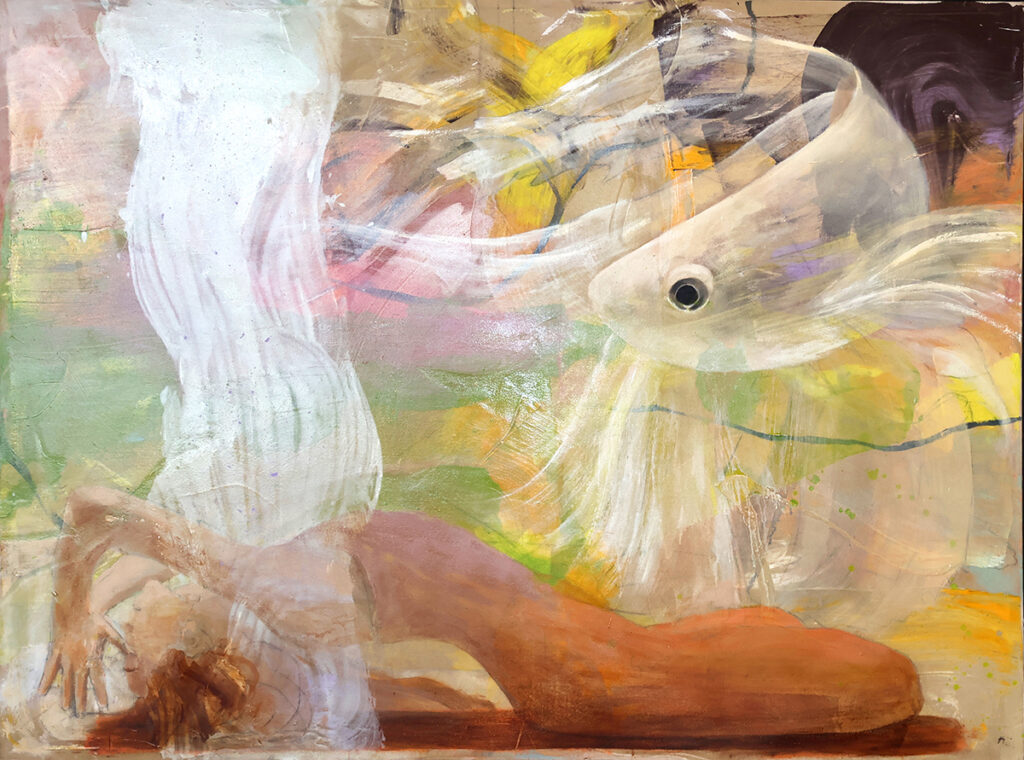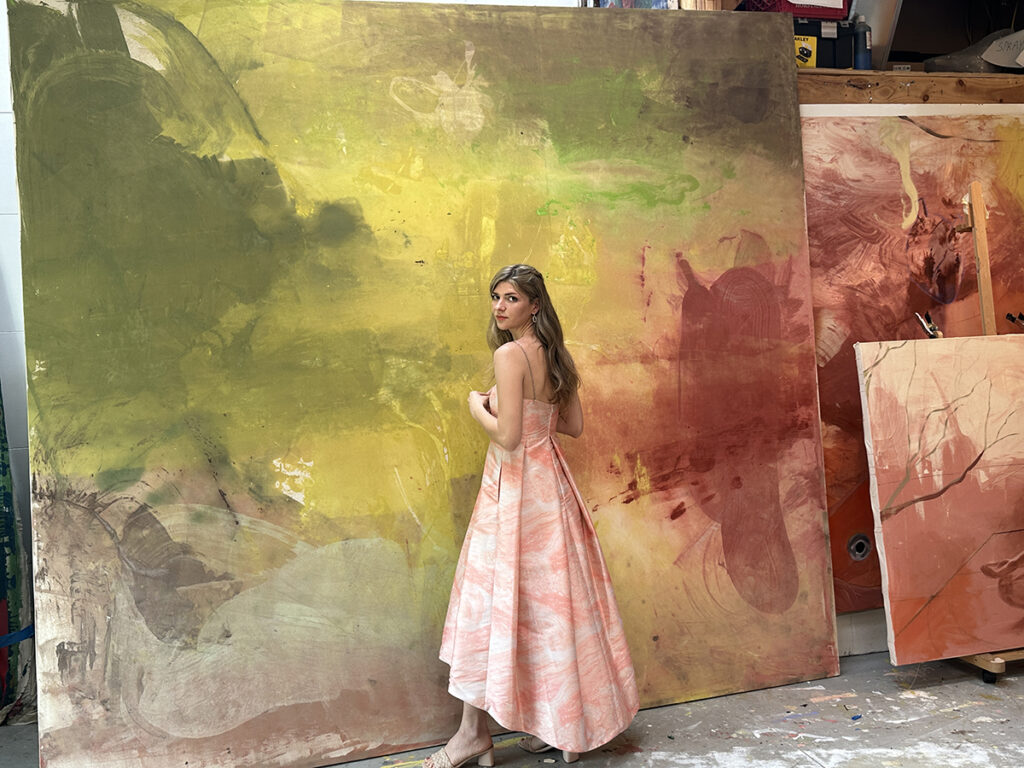
Flanders may be known for the Big Duck, but when you leave the main route and pass through a residential neighborhood to a dirt road with a gate, little do you know what lies ahead is a vibrant multi-generational art compound. Campo Cuttica is comprised of 40 acres of preserved land in Flanders with 10 art studios, leading a cutting-edge, collective art movement. Entering past a Monet-worthy lily pond, the compound stretches out with dogs and the smell of an Argentinian asado to greet visitors. Sculptures and studios with wide open doors invite in guests and the verdant landscape. For artist Isadora Capraro this is a slice of heaven. Her father-in-law with whom she apprenticed, the renowned artist Eugenio Cuttica, bought the property from the estate of sculptor Gloria Kisch who worked with the Town of Southampton to preserve the land, some of which was, no surprise, a duck farm. The current family compound of artists includes Capraro’s husband Lautaro Cuttica and brother-in-law Franco Cuttica. They often host group shows with artists from the compound as well as other local and New York City-based artists.
Capraro whose lineage is both Argentinian and Italian, was encouraged by her husband to paint and paint big, her works now featured in prominent shows and collections after only four years living in the US. Her work recently was exhibited at the Argentinian Consulate in New York City. At age 28, Capraro is both a young and old soul, tapping into ancient symbols and mythical mysteries in her work which shine through a fresh lens. Her latest collection depicts a dreamscape of yoga poses, often in tandem with fish peering through an all-knowing eye. “The fish is a symbol for many cultures and religions so it speaks directly to the unconscious,” says Capraro, “It goes deep.” Paired in a yin and yang fashion with the “fish” yoga pose, the images also evoke the power of asanas. “The cool thing about yoga is that the positions are so dynamic and require balance and you can play with it,” she comments. She seeks this same balance in her compositions while evoking her emotional message of peace of mind. “When people have my work in their home, I want it to bring calm. At this point in my career, I want to evoke serenity.” She adds with a laugh, “As I get older maybe I will get more dark.”

Using acrylics, oil paint, charcoal, and resin, Capraro paints a wide swath of color for effect. She comments on how moving from smaller canvases to larger ones affected the energy of her work. “When you are painting small you only move your hands, but when painting big you step into the painting and it requires your whole body. It is very corporeal.” With abstract work one of the challenges is knowing when a work is finished, when the canvas should be filled or benefits more from negative space. “It’s a hard decision of when a work is done,” she comments, “Too much can ruin it. As my husband says, ‘It’s better al dente than overcooked.’”
Capraro has connected with her audience through galleries, art consultants, and interior designers as well as museums. Good old-fashioned word of mouth is also a secret to her success. She finds the Hamptons to be a receptive audience. “When I moved here, a young girl about my age bought a painting from me. It drew me to this place where people are interested in art and can buy it. In Argentina, it is only a small amount of people who have access.” And those who buy her work follow her and root for her success. She says with a smile, “For my collectors, I am like a soccer team and they are cheering for me and they get happy when I achieve things.” Capraro also roots for her fellow artists gaining visibility through Campo Cuttica, “We want to make Flanders cool. And not just for the Big Duck. It’s our mission.”







![Join us May 6th at The Harmonie Club for the Spring Salon Luncheon, a beautiful gathering in support of a truly meaningful cause. Together, we’ll raise critical funds and awareness for @campgoodgriefeeh—@eastendhospice’s summer bereavement camp helping children and teens navigate loss with compassion, connection, and healing. [link in bio]](https://hamptonsrealestateshowcase.com/wp-content/uploads/sb-instagram-feed-images/491527001_18506092897030135_3117653411609489602_nfull.webp)
![Welcome to this exquisite custom-built home in the prestigious Quogue South estate section, just moments from Dune Road and some of the world’s most breathtaking ocean beaches. Completed in 2024, this expansive shingle-style residence offers 6 beds, 7 full and 2 half baths, a separate legal guest cottage, heated gunite saltwater pool with spa, all set on a beautifully manicured 0.74± acre lot. Represented by @lauren.b.ehlers of @brownharrisstevens. [link in bio]](https://hamptonsrealestateshowcase.com/wp-content/uploads/sb-instagram-feed-images/491516869_18505931593030135_4655757731678000577_nfull.webp)
![Discover 11 Oyster Shores, a unique marriage of thoughtful design, uncompromised execution and meticulous craftsmanship expressed across nearly 6,000± sq. ft. of highly curated living space. Brought to life under the watchful eye of Blake Watkins, the visionary behind WDD, the project is a refreshing departure from the ordinary. Represented by @nobleblack1 of @douglaselliman. [link in bio]](https://hamptonsrealestateshowcase.com/wp-content/uploads/sb-instagram-feed-images/491440257_18505740808030135_9064730571228880657_nfull.webp)
![Reserve your ad space now in the Memorial Day “Summer Kick-Off” Issue of #HRES! 🍋 Be seen by high-end buyers and sellers across the Hamptons, Manhattan, and South Florida—just in time for the start of the season. Secure your spot today and make waves this summer 🌊☀️ [link in bio]](https://hamptonsrealestateshowcase.com/wp-content/uploads/sb-instagram-feed-images/491441694_18505573426030135_4475989184561040528_nfull.webp)

![Tuesday, April 15, was Tax Day for most, but for someone in Palm Beach, it was closing day! The nearly 8,00± sq. ft. Mediterranean-style residence at 240 N Ocean Boulevard, with direct ocean views and a private, 100-foot beach parcel, closed at exactly $26,670,750. The seller was represented by Jack Rooney of @douglaselliman and Elizabeth DeWoody of @compass while Dana Koch of @thecorcorangroup brought the buyer. [link in bio]](https://hamptonsrealestateshowcase.com/wp-content/uploads/sb-instagram-feed-images/491445351_18505056166030135_4907944420436119099_nfull.webp)
![Previously featured on our 2024 Columbus Day issue cover, 74 Meeting House Road has officially sold! This stunning new construction in Westhampton Beach offers the perfect blend of thoughtful design and timeless style. Congratulations to @kimberlycammarata of @douglaselliman who held the listing! [link in bio]](https://hamptonsrealestateshowcase.com/wp-content/uploads/sb-instagram-feed-images/491441951_18504901357030135_2664904795600183799_nfull.webp)
![Located South of the highway in Southampton this 4 bedroom, 5.5 bath multi-story property, offers extensive exterior architectural detail throughout. 60 Middle Pond Road offers breathtaking views and tranquil living, nestled along the serene shores of Middle Pond and Shinnecock bay. Represented by @terrythompsonrealtor @douglaselliman. [link in bio]](https://hamptonsrealestateshowcase.com/wp-content/uploads/sb-instagram-feed-images/491451873_18504686110030135_5284427082339135969_nfull.webp)
